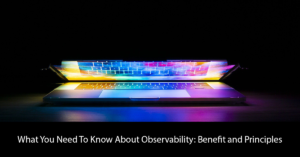Monitoring alone cannot handle the complexities that come with microservices, cloud computing etc. This is therefore when Observability comes into play here. Most importantly, a roadmap to observability.
Whether you like it or not, changes in enterprise tech, application, and network infrastructures are happening at an unprecedented rate. Not to mention the massive chunk of data produced and the complexities that come with the distribution of these systems. Since digital services form the core solution of almost all enterprise transactions, interactions, and workflow, ensuring that effective IT operation monitoring is available guarantees that these systems perform optimally.
A lot has happened since the start of the global pandemic last year. I&O leaders had to reevaluate their IT operations strategies with the current situation and an outlook to the future. In other words, many companies with digital transformation plans to be implemented through 2025 had to make dramatic shifts in two to three months.
Harsh Realities That Made The Need For a Roadmap to Observability
As we gradually enter the fourth quarter of 2021, IT Ops teams would certainly not want to continue working under overwhelming tensions. However, they need first to accept these harsh realities:
- The explosion of data and modern architectures and operational overhead of disparate point tools have complicated issues. Metric fatigue.
- Unavailability for IT Ops teams to link and monitor scattered technology domains
- Minimized efficiency of application insights and visibility into errors with traditional monitoring from multiple sources.
- Journey through long roads towards achieving the unicorn status of Zero Mean Time to Resolution (MTTR) across distributed systems.
How can ITOps teams move past these problems? Monitoring alone cannot handle the complexities that come with microservices, cloud computing etc. Maybe if we give it a little boost, things can get better? Observability comes into play here. We want to align with the school of thought that calls it “monitoring-on-steroids.”
In the following sections, we will discuss observability and the roadmap I&O leaders must follow to remain in light through 2025.
What Is Observability: Monitoring-On-Steroids
Observability can be defined as the building systems and applications to collect metrics and log data. Observability allows IT Ops teams to gain visibility into systems in terms of managing and enhancing their performance. This concept was handpicked from the system control theory, the core of feedback systems, which states that observability is a measure of how well the internal states of a system can be inferred by knowledge of its external outputs.
The higher meaning of this is that the more observable a system is, the more valuable insights you can get from log events/metrics. DevSecOps teams can wait to hold the full potential of observability as it seems to be the most critical consideration for adapting to the shift transformation of the IT enterprise environment.
Pillars Of Observability
Logs/Events, metrics, and traces form the main pillars needed for observability. With a clear grasp of what observability means, we must understand the benefits and the next step to achieving them. Some I&O leaders will say that collecting data you will not use is useless, but we say the more data you collect, the better observability. But without these pillars cutting across stacks, technology, and all environments, it won’t be easy to harness the benefits of observability.
Logs: form immutable records of private events happening over time.
Metrics: Account for numbers describing a particular process measured over a period.
Tracing: This data displays the coding journey and can pinpoint which code fails at the individual user level for previously occurring events. Tracing can detect which method was invoked within that instance, how the request was performed, and the results.
Roadmap To Observability
Conventional monitoring approaches allowed IT operators to track simple and static systems within an isolated stack. Outputs were easily observable and made tracking incident response and predictive behaviors easier. In today’s enterprise environment, things have changed. It’s no more business as usual as teams are tasked with implementing cloud-based microservices with complex ephemerals and constant entropic states. I&O leaders have realized that it’s more challenging to apply conventional monitoring strategies when it’s virtually impossible to truly understand performance amidst infrastructure complexities.
I&O leaders must reevaluate their goals and approaches and move from conventional monitoring to pragmatic observability. Observability is monitoring-on-steroids. It gives a more comprehensive insight, leading to seldom quality problems, high-quality products, and in the end, happier App users. Every organization has peculiar observability needs, which means they should be followed uniquely. A proper roadmap to observability should be considered. Gartner’s recent research revealed that by 2025, 70 percent of new cloud-native application monitoring would assign open-source instrumentation instead of vendor-specific agents for improved interoperability. Therefore, there is no better time than now to establish a solid roadmap to observability to stay relevant through 2025.
The following roadmap can help I&O leaders successfully move through with observability;
- Make Observability pragmatic
- Choose an Observability Platform that Fits Your Future
- Monitor the metrics that matter
- Quick adoption of AIOps and ML to intelligently drive automation
Make Observability Pragmatic
Since DevOps is changing, observability should be introduced right from the start of the development life cycle rather than as an afterthought. Observability should be actionable and consolidated with advanced solutions and strategies that promote DevOps teams to work together at a very high level. Such collaborations will certainly push observability to the core of most application performance monitoring.
Choosing The Right Observability Platform
Whether you like it or not, enterprise technology will continue to evolve. As such, the right observability platform today might not be the one that will save you in the next five years. I&O leaders must think about observability in a futuristic sense. As long as IT investments are shifting towards new techs such as microservices, containers, Kubernetes, and cloud, an increase in scalability and ephemerality will surface. Therefore, ITOps teams must choose platforms that can serve them today and in the near future. Hopefully, the kind of disruption caused by COVID-19 doesn’t happen again. Whether you choose an open-source or commercial tool, your decision based on your observability needs today and soon should shape your selection process.
Quick Adoption of AIOps and ML To Intelligently Drive Automation
Artificial intelligence is cutting across almost every sphere of IT, including observability. Since the volume and disparity of data needed to provide valuable insights about the enterprise are huge, turning to sophisticated analytic techniques that leverage Artificial Intelligence (AI) and machine learning (ML) is the step in the right direction. I&O leaders need to optimize the use of AI and ML in their production environments because high-quality observability systems have machine learning capabilities to understand beyond the past health of your services and predict occurrences in the future.
Your business can benefit from quick adoption of AIOps to your roadmap to observability via the following;
- Duplicate events are canceled automatically to reduce frequent and irrelevant alerts
- Add context to events to make them consolidated and pragmatic
- Surfing through a huge number of metrics and events has never been easier
Monitor The Metrics That Matter
We have highlighted some metrics, events, and traces that will be crucial in achieving the proper roadmap to observability.
| Pillars of Observability | Metrics that matter |
| Metrics | Frequent metrics sources:
|
| Logs/Events | Whether plain text, structured or binary. Common event sources:
|
| Traces | The user’s journey is collected from a specific standpoint. They include:
|
The Reward: Gain Critical Insights Into Your Application With FusionReactor
To conclude, there are some observable solutions out there, but most importantly, I will talk about our solution, The FusionReactor solution. FusionReactor has one of the best observability solutions because it is easy to use, runs on Kubernetes, ECS, serverless and more. In addition, you can also correlate metrics and logs as well as traces with super important payload visibility. Finally, we offer an end-to-end solution that allows you to troubleshoot across different business teams, operations, and development. Security and privacy are crucial to any observability solution, and our founding team has come from a heavy security background with ISO certifications and is GDPR compliant.
Please, if it’s still too confusing, reach out to us at FusionReactor. We will be more than happy to help in any way we can with your fully observable AIOps journey!



